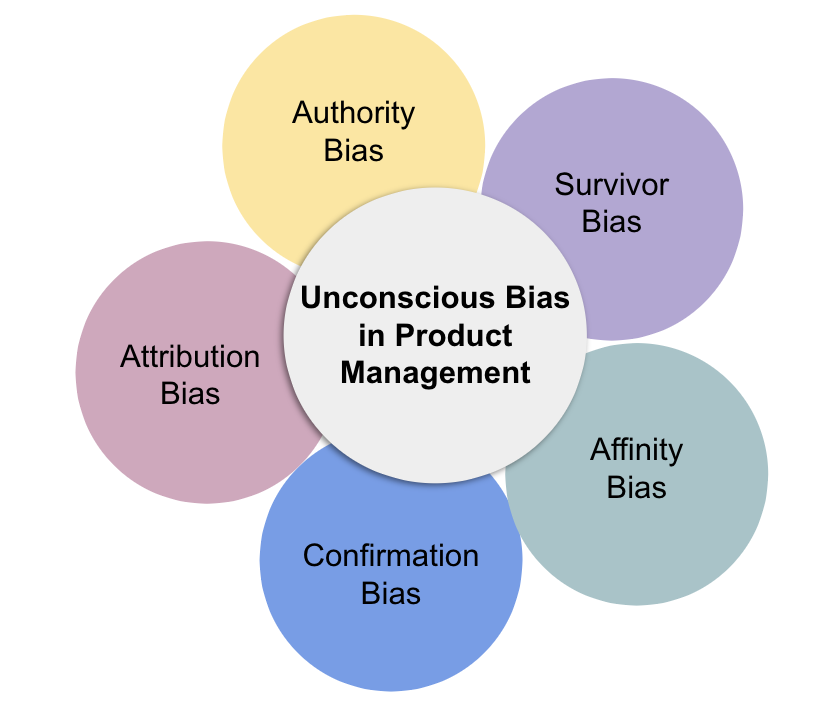Product management involves building new products or features and managing the product through its lifecycle to achieve product-market fit. As a product manager, you face new challenges everyday as you need to make decisions that are crucial for the journey of the product.

Such decisions can be impacted by the unconscious bias that everyone carries. These unconscious biases are automatic mental shortcuts inherited from social norms and stereotypes that impact your perceptions, actions, and decisions without conscious awareness.
In product management, unconscious biases can impact decision making in various activities like designing, user research, and even deciding what needs to be built. Because of unconscious biases, PMs can create products catered to a subset of the target segment that promote stereotypes and miss the needs of the customers.
This post will explore the world of unconscious bias in product management. It will help you to understand the meaning of unconscious bias, how it embeds into product management, and the importance of addressing it.
Unconscious or implicit bias refers to subconscious attitudes toward others and your surroundings. Each individual has a lot of information within their mind that gets stored from reading, viewing, and experiencing the world. Over time, these become ingrained and shift your perceptions without your conscious awareness.
Within the realm of product management, there are different types of biases that can exist and impact product development. Let’s understand the most common ones and how to avoid them:

Authority bias happens when more importance is placed on an idea because it was shared by an authoritative person. This tends to be the most common bias found in product management. Although PMs are responsible for the product, the harsh truth is that many times executives voice ideas that PMs then have to build.
This happens because of the hierarchy that exists within companies. As a product manager, you’re an individual contributor who often reports directly to executives. Because of this, you might find yourself in a situation where you can’t say no to product requirements even though these requirements might not meet the needs of the customer.
If you’re facing this challenge, try the following steps:
Confirmation bias refers to drawing conclusions towards a situation based on your desires or beliefs rather than considering facts. Sometimes you might become emotionally attached to a product you’re building and might then be inclined to develop it because of your own personal desires.
Such a bias could lead to you not conducting user surveys or interviews to dig deeper into the user’s problem. This can eventually lead to building something that might not solve for a user’s pain points.
It’s crucial that you analyze the available data and do the necessary research on the customer needs and the market before making any product decision. Try to avoid making decisions based on your gut feeling. Instead, take a step back to visualize the big picture and ensure your product-related decisions are based on facts.
A tendency to connect with others who have similar interests and experiences is called an affinity bias. Product managers are expected to be unbiased when making product decisions or performing product related activities. However, you might find yourself favoring thoughts shared by a teammate or a stakeholder even though that thought or idea might not be the best for the product.
You might even hire people that you connect with due to affinity bias, even though that individual might not have the right skills. Affinity bias impacts the team dynamics and ultimately the decisions made.
Attribution bias occurs when an individual attributes success to internal factors such as their skills, efforts, and ideas, but fails to acknowledge external factors beyond their control. For example, product teams might attribute the success of a feature to their efforts, skills, or knowledge and neglect the fact that it was needed by the customers.
Whether a product feature failed or was a success post launch, analyze the data and confirm if your solution actually solved a problem or if there was a loophole in the hypothesis somewhere. For example, you might not have considered a use case during implementation that leads to users getting stuck on the feature instead of being able to complete the action that they were supposed to.
In this case, the feature launched was not successful up to the expected level because of a missed use case. Another reason could be a bug in the production that happened during the release. In both cases, the solution is to identify the root cause and fix it as soon as possible instead of blaming internal teams or outside factors.
Survivorship bias happens when you focus on the survivors or successful individuals in a group and ignore the “non-survivors” in the group. Sometimes PMs fail to gather data from all sources and might take decisions based on readily available data. For example, product managers might review the comments submitted on the Apple or Google Play store alone, instead of reaching out to a variety of customers and gathering their feedback.
As a PM you must be an expert on user pain points. Understand who your customers are and the problems that they face. While researching users, ensure that you’re covering different type of personas and utilizing all the available data sources.
Unconscious bias can lead to a number of problems that can impact the team’s productivity and the product development as well. Analyzing unconscious bias within yourself and taking necessary steps to stop the unconscious bias at the individual level is the first step toward creating an unbiased team environment. Tackling unconscious bias leads to:
To create successful products, it’s vital to overcome unconscious bias. You can overcome unconscious bias through increased self-awareness and unconscious bias training.
The first step is to identify if unconscious bias is creeping into your product related activities. To identify this, spend 10 minutes every day to reflect on the decisions made during the day and the discussions that happened. Analyze your behavior and see if there was a possibility of it being influenced by unconscious bias.
Keep your analysis in mind for the next day and challenge yourself before taking any product related decision.
Another approach involves outright acknowledging the presence of unconscious bias and taking active steps to combat it. You can set up training for your product team to help them become aware of the unconscious biases in product management.
Many PMs aren’t even aware of how unconscious bias might be impacting their decisions. Conducting training to help you understand the types of unconscious bias and its impact on product development is the first step you can take toward ensuring successful product launches.
Unconscious bias often lurks beneath the surface and influences key decisions, user research, and design in product development. If unchecked, these biases can lead to products targeted to a subset of the target segment. Acknowledging and addressing unconscious biases with continuous self-awareness and education is a key step toward building products designed for a diverse user base.
Featured image source: IconScout
LogRocket identifies friction points in the user experience so you can make informed decisions about product and design changes that must happen to hit your goals.
With LogRocket, you can understand the scope of the issues affecting your product and prioritize the changes that need to be made. LogRocket simplifies workflows by allowing Engineering, Product, UX, and Design teams to work from the same data as you, eliminating any confusion about what needs to be done.
Get your teams on the same page — try LogRocket today.

Great product managers spot change early. Discover how to pivot your product strategy before it’s too late.

Thach Nguyen, Senior Director of Product Management — STEPS at Stewart Title, emphasizes candid moments and human error in the age of AI.

Guard your focus, not just your time. Learn tactics to protect attention, cut noise, and do deep work that actually moves the roadmap.

Rumana Hafesjee talks about the evolving role of the product executive in today’s “great hesitation,” explores reinventing yourself as a leader, the benefits of fractional leadership, and more.